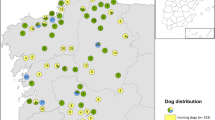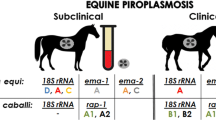Abstract
Positive PCR results for piroplasms were obtained on EDTA blood samples from 166 dogs and 111 horses between March 2006 and March 2008. The organisms were initially identified using common primers, followed by restriction enzyme profiles to determine the species and types of Babesia/Theileria. In 27 dogs and eight horses with positive results, the size of the specimen was insufficient to separate species/types. We identified Babesia canis canis in 105 of the 166 dogs (63%) and Theileria equi in 89 of the 111 horses (80%). Babesia caballi was also present, but rare, in only two Babesia/Theileria of the 111 horses (1.2%). Unexpected findings were the identification of T. equi in 31 of the 166 dogs (19%), of B. caballi in one of the 166 dogs (0.6%), of B. canis canis in 11 of 111 horses (10%), as well as of Babesia canis rossi in one of 111 horses (0.9%). A positive result for B. canis rossi was also obtained in one of the 166 dogs (0.6%). A single case of the California type of “Babesia gibsoni” (presumably Babesia conradae) was found in a dog. We did not detect Babesia canis vogeli, possibly because of the geographic distribution of our clients. The unusual results were confirmed by DNA sequencing in several cases for B. canis canis and B. canis rossi in horses, as well as T. equi in dogs. Such infections might explain the difficulties met in some unsuccessfully treated animals using the standard dosage of imidocarb dipropionate at 3 mg/kg in dogs.
Similar content being viewed by others
References
Apanaskevich DA, Horak IG, Camicas JL (2007) Redescription of Haemaphysalis (Rhipistoma) elliptica (Koch, 1844), an old taxon of the Haemaphysalis (Rhipistoma) leachi group from East and southern Africa, and of Haemophysalis (Rhipistoma) leachi (Audouin, 1826) (Ixodida, Ixididae). Onderstepoort J Vet Res 74(3):181–208
Beck R, Vojta L, Mrljak V, Marinculić A, Beck A, Živčnjak T, Cacciò SM (2009) Diversity of Babesia and Theileria species in symptomatic and asymptomatic dogs in Croatia. Int J Parasitol 39:843–848
Boozer L, Macintire D (2005) Babesia gibsoni: an emerging pathogen in dogs. Comp Cont Educ Pract Vet 27:33–41
Criado A, Martinez J, Buling A, Barbara JC, Merino S, Jefferies R, Irwin PJ (2006) New data on epizootiology and genetics of piroplasms based on sequences of small ribosomal subunit and cytochrome b genes. Vet Parasitol 142:238–247
Criado-Fornelio A, Martinez-Marcos A, Buling-Saraña A, Barba-Carretero JC (2003) Molecular studies on Babesia, Theileria and Hepatozoon in southern Europe. Part I. Epizootiological aspects. Vet Parasitol 113:189–201
Irwin PJ (2009) Canine babesiosis: from molecular taxonomy to control. Parasit Vectors 2(suppl 1):S4. doi:10.1186/1756-3305-2-S1-S4
Kjemtrup AM, Wainwright K, Miller M, Penzhorn BL, Carreno RA (2006) Babesia conradae, sp. Nov., a small Babesia identified in California. Vet Parasitol 138:103–111
Saiki RK, Scharf S, Faloona F, Mullis KB, Horn GT, Erlich HA, Arnheim N (1985) Enzymatic amplification of beta-globin genomic sequences and restriction site analysis for diagnosis of sickle cell anemia. Science 230:1350–1354
Tabar MD, Francino O, Sánchez A, Ferrer L, Roura X (2009) PCR survey of vectorborne pathogens in dogs living in and around Barcelona, an area endemic for leishmaniosis. Vet Rec 164:112–116
Vial HJ, Gorenflot A (2006) Chemotherapy against babesiosis. Vet Parasitol 138:147–160
Wulansari R, Wijaya A, Ano H, Horii Y, Nasu T, Yamane S, Makimura S (2003) Clindamycine in the treatment of Babesia gibsoni infections in dogs. J Am Anim Hosp Assoc 39:558–562
Acknowledgements
I am grateful to professor Gerrit Uilenberg (Cargèse, France, ICTTD) for his help in editing the manuscript and searching the bibliography; to Dr. Kathy Freeman (Idexx, Scotland) for her help in the ECVCP Barcelona presentation, where results of this study were first presented in September 2008; to Professor J. P. Braun (Ecole Nationale Vétérinaire Toulouse, France) and Professor J. Guillot (Ecole Nationale Vétérinaire Alfort, France) for their encouragement and help; to Dr A. Castillo (DMV, France) for her help to summarising the results; to Professor Gad Baneth (The Hebrew University of Jerusalem, Israël) for sending me DNA sample of B. canis vogeli and to Dr. Remo Lobetti, Bryanston, South Africa, for sending me a DNA sample of B. canis rossi. And last but not least, to the technician’s team of our Companion Animal Laboratory.
Author information
Authors and Affiliations
Corresponding author
Rights and permissions
About this article
Cite this article
Fritz, D. A PCR study of piroplasms in 166 dogs and 111 horses in France (March 2006 to March 2008). Parasitol Res 106, 1339–1342 (2010). https://doi.org/10.1007/s00436-010-1804-3
Received:
Accepted:
Published:
Issue Date:
DOI: https://doi.org/10.1007/s00436-010-1804-3




